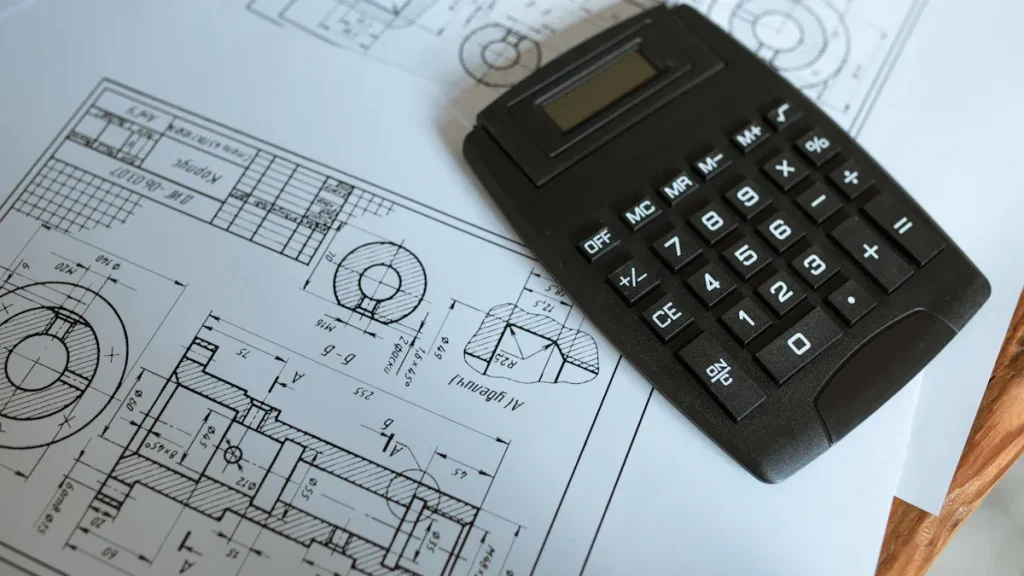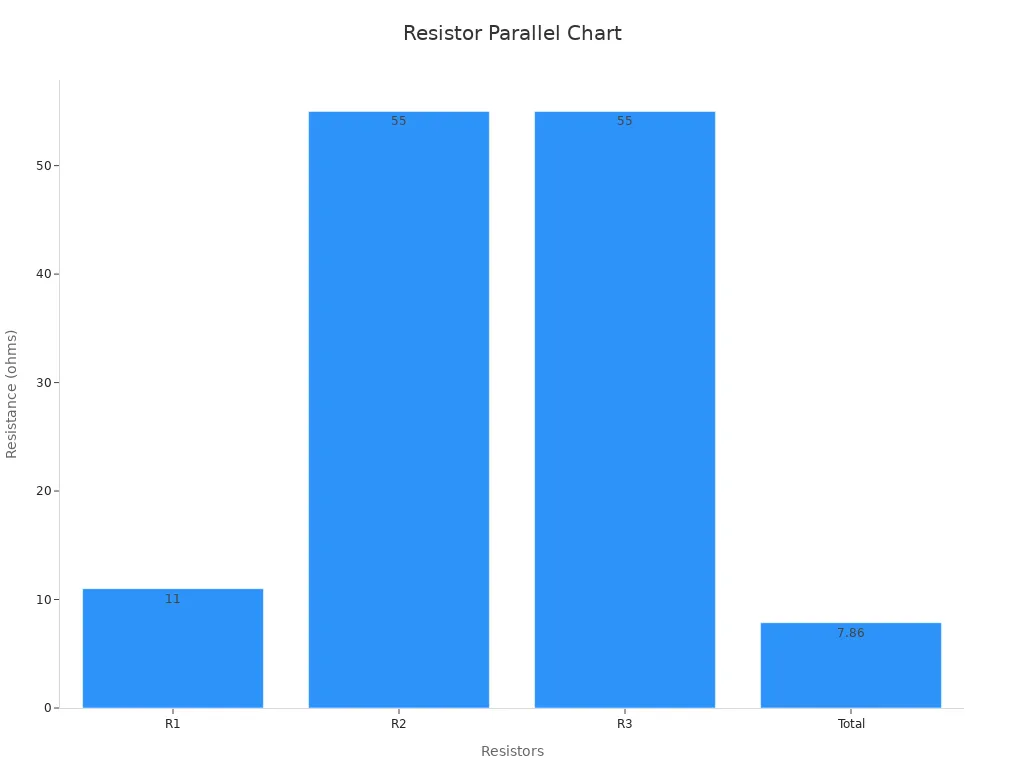
Understanding total resistance in a parallel and series circuit is important for working with circuits.
In a series circuit, add all resistance values together.
Use this formula:
For parallel circuits, the method is different.
Use this formula:
These formulas help you study total resistance in a parallel and series circuit better. Knowing this makes it easier to fix and design electrical systems.
Key Takeaways
In series circuits, add all resistor values to get total resistance. Use the formula: R_total = R1 + R2 + R3 + … + Rn.
For parallel circuits, use this formula: 1/R_total = 1/R1 + 1/R2 + 1/R3 + … + 1/Rn.
Knowing the difference between series and parallel circuits is important. It helps you design and fix electrical systems better.
Start with simple examples to practice finding total resistance. This will help you feel ready for harder circuits later.
Learning to calculate total resistance keeps electrical devices safe and working well.
Total Resistance in Series Circuits

Understanding Series Circuits
A series circuit is one of the easiest electrical setups. In this type of circuit, resistors are connected one after another. This creates a single path for the current to move through. The current stays the same everywhere in the circuit. However, the voltage drops across each resistor. This makes series circuits simple to understand and work with.
The total resistance in a series circuit comes from energy conservation. The energy from the source equals the energy used by the resistors. This gives the equation V = V1 + V2 + V3. So, the total resistance Rs of three resistors is Rs = R1 + R2 + R3. This rule works for any number of resistors in series.
Series circuits are often used when the same current needs to pass through all parts. Examples include string lights or basic battery-powered gadgets.
Formula to Calculate Total Resistance in Series Circuits
To find the total resistance in a series circuit, add up all the resistor values. The formula is:
Here, R_total is the total resistance. R1, R2, R3, and so on are the resistances of each resistor. This formula works because the current flows through each resistor in order. The resistances combine to form the total resistance.
For instance, if you have three resistors with values of 5 ohms, 10 ohms, and 15 ohms, the total resistance is:
This simple method makes it easy to calculate total resistance in a series circuit.
Step-by-Step Example for Total Resistance in Series Circuits
Let’s go through an example to calculate total resistance in a series circuit. Suppose you have three resistors in series with these values: 4 ohms, 6 ohms, and 8 ohms. Follow these steps:
Understand the Circuit: The resistors are in series. The current flows through them one by one.
List the Resistances: Write down the resistor values: R1 = 4 ohms, R2 = 6 ohms, R3 = 8 ohms.
Use the Formula: Apply the formula for total resistance:
R_total = R1 + R2 + R3nDo the Math: Add the resistor values:
R_total = 4 + 6 + 8 = 18 ohmsnCheck Your Work: Make sure your addition is correct.
The total resistance of this series circuit is 18 ohms. This means the circuit acts like it has one resistor with 18 ohms.
Experiment | Explanation |
|---|---|
Shows how a capacitor charges through a resistor in series, explaining the time constant. | |
Series Capacitors | Explains how connecting capacitors in series changes the charge time. |
By learning these steps and practicing examples, you can easily calculate total resistance in any series circuit.
Total Resistance in Parallel Circuits

Understanding Parallel Circuits
A parallel circuit connects resistors across the same two points. This setup lets current flow through multiple paths. Unlike series circuits, the voltage stays the same across each resistor. The current splits into different paths based on each resistor’s value.
Parallel circuits are used in many everyday devices. For example, home outlets are connected in parallel. This lets each device get the same voltage and work independently.
Experts have studied parallel circuits to understand their behavior. Research from 2012 explains how they share current and keep voltage steady across components. These studies help us understand their practical uses.
Formula to Calculate Total Resistance in Parallel Circuits
To find total resistance in a parallel circuit, use this formula:
Here:
R_total is the total resistance.
R1, R2, R3, … Rn are the resistances of each resistor.
This formula works because the current flows through many paths, lowering the total resistance. The table below shows formulas for both series and parallel circuits:
Description | Formula |
|---|---|
Resistance in Series | Req = R1 + R2 + ... |
1/Req = 1/R1 + 1/R2 + ... |
Special tools help measure resistance in parallel circuits accurately. For example:
The 6-wire method reduces errors caused by extra resistances.
A guard amplifier ensures current flows only through the correct resistors.
These tools are useful for testing parts on circuit boards or other complex systems.
Example Calculation for Two Resistors in Parallel
Let’s calculate total resistance for two resistors in parallel. Suppose the resistors are 6 ohms and 12 ohms. Follow these steps:
Understand the Circuit: The resistors are in parallel, so the current splits between them.
Write the Formula: Use the formula for parallel resistance:
1/R_total = 1/R1 + 1/R2nSubstitute the Values: Replace R1 and R2 with their values:
1/R_total = 1/6 + 1/12nFind a Common Denominator: Rewrite the fractions:
1/R_total = 2/12 + 1/12 = 3/12nInvert the Result: Flip the fraction to find R_total:
R_total = 12/3 = 4 ohmsn
The total resistance of this parallel circuit is 4 ohms. This means the circuit acts like it has one resistor with 4 ohms.
Experiments show how current flows in parallel circuits. For example:
The total circuit current equals the supply voltage divided by the total resistance.
Ohm’s law helps confirm the resistance calculations.
By practicing these steps, you can easily calculate total resistance in any parallel circuit.
Example Calculation for Three or More Resistors in Parallel
When finding total resistance for three or more resistors in parallel, the steps are similar to two resistors. The current splits into multiple paths, lowering the total resistance. Let’s go through it step by step.
Step-by-Step Calculation Example
Imagine a parallel circuit with these resistors:
R1 = 11 ohms
R2 = 55 ohms
R3 = 55 ohms
Follow these steps to calculate total resistance:
Write the Formula: Use this formula for parallel circuits:
1/R_total = 1/R1 + 1/R2 + 1/R3nSubstitute the Values: Replace R1, R2, and R3 with their values:
1/R_total = 1/11 + 1/55 + 1/55nSimplify the Fractions: Find a common denominator:
1/R_total = 5/55 + 1/55 + 1/55 = 7/55nInvert the Result: Flip the fraction to find R_total:
R_total = 55/7 ≈ 7.86 ohmsn
The total resistance of this parallel circuit is about 7.86 ohms. This means the circuit acts like it has one resistor with 7.86 ohms.
Real-World Example with Voltage and Current
Here’s how total resistance affects the circuit:
Resistor | Voltage (V) | Current (I) | Resistance (R) |
|---|---|---|---|
R1 | 110 | 10 | 11 ohms |
R2 | 110 | 2 | 55 ohms |
R3 | 110 | 2 | 55 ohms |
Total | 110 | 14 | 7.86 ohms |
This table shows that the voltage stays the same across all resistors in parallel. The current changes based on each resistor’s value. The total current is the sum of all currents, and the total resistance is calculated using the reciprocal method.
Visual Representation of Resistor Values
Here’s a bar chart to compare resistor values and total resistance in this parallel circuit:

This chart shows how adding more resistors in parallel lowers the total resistance, making the circuit better at sharing current.
Key Takeaways
When working with three or more resistors in parallel, remember:
Total resistance is always less than the smallest resistor.
Use the reciprocal formula to calculate total resistance.
Tables and charts help explain the link between voltage, current, and resistance.
By practicing these steps, you’ll better understand parallel circuits and use these ideas in real-life situations.
Total Resistance in a Parallel and Series Circuit (Combination Circuits)
What Are Combination Circuits?
Combination circuits mix series and parallel connections in one system. Some parts have resistors in series, while others have resistors in parallel. These circuits are more complex than simple series or parallel circuits.
Learning about combination circuits helps in real-world applications. Devices like home appliances and car electronics use them to manage current and voltage. By calculating total resistance, you can simplify these circuits into one equivalent resistance.
Here are some helpful resources:
Guides explain how to calculate total resistance in combination circuits.
Lessons focus on understanding both series and parallel concepts.
Advanced materials show how to simplify complex circuits step by step.
Steps to Calculate Total Resistance in a Parallel and Series Circuit
Follow these steps to find total resistance in combination circuits:
Find Series and Parallel Parts: Look at the circuit to see which resistors are in series and which are in parallel.
Add Series Resistances: Use this formula for resistors in series:
R_series = R1 + R2 + R3 + ...nCalculate Parallel Resistances: Use the reciprocal formula for resistors in parallel:
1/R_parallel = 1/R1 + 1/R2 + 1/R3 + ...nCombine Results: Replace each section with its equivalent resistance. Repeat until the circuit becomes one equivalent resistance.
This method makes it easier to solve even complicated circuits.
Example Calculation for Combination Circuits
Here’s an example with these resistors:
R1 = 10 ohms (in series)
R2 = 20 ohms and R3 = 30 ohms (in parallel)
Find Parallel Resistance:
1/R_parallel = 1/R2 + 1/R3n1/R_parallel = 1/20 + 1/30n1/R_parallel = 3/60 + 2/60 = 5/60nR_parallel = 60/5 = 12 ohmsnAdd Series Resistance:
R_total = R1 + R_parallelnR_total = 10 + 12 = 22 ohmsn
The total resistance of this circuit is 22 ohms. This process simplifies the circuit into one equivalent resistance, making it easier to understand.
Practical Uses of Total Resistance Calculations
Why Knowing Total Resistance Matters
Learning to calculate total resistance is key for safe circuits. It helps ensure systems work well and avoid problems. For example, in batteries, knowing resistance improves performance. If cells have different resistances, current may flow unevenly. This can lower efficiency or cause overheating. Measuring resistance also helps check battery health and predict how it will perform.
Evidence | Importance |
|---|---|
Knowing cell resistance helps understand battery performance in different conditions. | Shows why resistance calculations are needed for better battery use. |
Uneven resistance in series or parallel cells can cause power issues. | Explains why balanced resistance is important for battery safety. |
Tools like DC and AC loads measure resistance, which changes with charge and temperature. | Highlights the need for accurate resistance checks for battery health. |
Resistance data helps set limits and predict performance. | Proves the value of resistance calculations in real-world tasks. |
By learning these skills, you can fix problems and make systems more reliable.
Real-Life Examples of Using Resistance Calculations
You’ll need resistance calculations in many everyday tasks. Electricians use them to design home wiring that handles power safely. Engineers rely on them to improve power grids, where resistance affects energy flow. In cars, resistance calculations help balance power across parts, improving safety and performance.
For battery devices, resistance calculations predict battery life and ensure proper function. For instance, a device with a 3.7V battery and 37 ohms resistance can have its power use calculated. This helps manufacturers create devices that last longer and work better.
Everyday Devices and Resistance Examples
Resistance calculations are important in common electronics. In heaters, high-resistance wires turn electricity into heat. This shows how resistance affects how devices work. In LED circuits, the right resistor keeps the LED safe. For example, a 600Ω resistor works well for a 20mA LED with a 12V power source.
Example | Explanation |
|---|---|
Heaters | High-resistance wires turn electricity into heat for warmth. |
LED Circuit | |
Toaster | A toaster with 10 ohms draws 12A from 120V, showing power use. |
Motor Issue | A motor drawing 1A instead of 2A shows a possible problem. |
Portable Device | A 3.7V battery with 37 ohms helps estimate battery life. |
Power Transmission | A cable with 0.5 ohms loses 50V per kilometer, affecting grids. |
These examples show how resistance calculations are useful in daily life. By understanding them, you can solve problems, design better systems, and make smarter choices about electronics.
Knowing how to find total resistance is very important. In a series circuit, you add all the resistors together:
For parallel circuits, use this formula instead:
Learning these steps helps you fix and design circuits. Series circuits are easier to study because current flows in one path. Parallel circuits let parts work separately without affecting each other. Try solving simple examples first to understand better. Then, move on to harder circuits as you practice more. This way, you’ll learn the ideas step by step.
FAQ
1. What makes series and parallel circuits different?
Series circuits have one path for current to flow. The resistances add together. Parallel circuits split current into many paths, lowering total resistance. Series circuits share the same current, but parallel circuits share the same voltage.
2. Why does parallel resistance become smaller?
Parallel circuits let current flow through several paths. This lowers resistance because current spreads out. Adding more resistors in parallel makes the total resistance even smaller.
3. How can you find total resistance in combination circuits?
Look for series and parallel parts in the circuit. Use the right formula for each section. Combine the results step by step to find the total resistance. Simplify the circuit as you calculate.
4. Can total resistance ever equal zero?
No, total resistance cannot be zero unless there’s a short circuit. A short circuit happens when current skips all resistors. This creates a direct path with no resistance and can harm the circuit.
5. Why is learning about total resistance useful?
Knowing total resistance helps make circuits safe and efficient. It ensures current flows correctly and avoids overheating. This skill is important for fixing and improving electrical systems in everyday life.